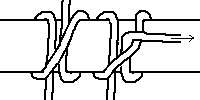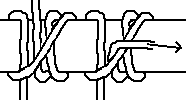![]()
Standard copyrights and disclaimer. Hitches (
|
![]()
In this table you find the most elementary hitches. The hitches in each column are closely related. The top hitch is tied round a pole or other object. I will refer to them as primary-elementary Hitches. The hitches there under are 'the same' but tied round the standing part of the rope. I will refer to them as secondary-elementary Hitches. But beware, the application of the variants are very different. The primary-elementary Hitches will spill if the object is removed. The secondary-elementary hitches will not. Some of the secondary-elementary hitches are 'capsized' bindery knots. As for all knots working the knot well is for these knots extremely important. Work it wrong and you might end up with another (probably unwanted) knot. For example, capsizing the two half hitches might end up in a granny knot, one of the worst of all knots. On the other hand if you know what you are doing, you might tie the wrong knot on purpose and capsize it to the hitch you want. Take care!
 |
Single Simple |
 |
Clove |  |
Rolling Magnus |
 |
Cow |
 |
Half |  |
Two Half |  |
Midshipmans Tautline |
 |
Reversed Half |
 |
Buntline |  |
Adjustable Jamming |
 |
Lobster Buoy |
![]()
(also called The Simple Hitch)
 Although
this is probably the simplest knot of all, you have to be a skilled knot-tyer to know how
to tye and use it in a safe way. The loose end of the rope is nipped against the object
and the standing part. The best nip is obtained against an edge or shoulder. If the load
is released and the standing part shaken, the hitch is spilled instantly.
Although
this is probably the simplest knot of all, you have to be a skilled knot-tyer to know how
to tye and use it in a safe way. The loose end of the rope is nipped against the object
and the standing part. The best nip is obtained against an edge or shoulder. If the load
is released and the standing part shaken, the hitch is spilled instantly.
![]() It is used
to attatch rope to a belay-pin, a weaver needle or even to a tree branch, to start
belaying, to start winding or as a temporary easy to spill made-fast.
It is used
to attatch rope to a belay-pin, a weaver needle or even to a tree branch, to start
belaying, to start winding or as a temporary easy to spill made-fast.
The Single Hitch
on the WEB.


This is the capsized overhand knot. It is very useful to carry light loads which have
to be removed easily. Ashley recommends it to use it for hanging store to out of reach for
mice. It should not be disturbed.
The Half Hitch on
the WEB.



This is a very important knot of only theoretical value. Without extra support, it is
untrustworthy in any situation, except as a crossing knot. You have to learn it for
scouting and at sailing schools. If you have to use it, work it up properly; pull
length-wise only at both ends before you load the working end. It is better to use The Rolling Hitch instead.
The Clove Hitch on
the WEB.

The two half hitches is used for tieing a rope with a right-angle pull to a pole or
ring. It should be constant under load. (Not under constant load). It does not jam. If the
object you tye it on has a small diameter it is better to use the "Round Turn with
Two Half Hitches". This is the same knot but with an extra turn round the object.
The Two Half Hitches
on the WEB.

The Buntline Hitch is (was) used to tie a buntline to a square sail. It is a secure
knot, but it tends to jam, so it is not easy to untie. Therefore, it is useful for work
that will be left unattended for longer periods, since it will not untie suddenly.
The Buntline Hitch on
the WEB.
 The best simple
hitch for lengthwise pull. It needs to be laid very carefully and pulled firmly before
loading. Never use it for right angle pull, for it will spill.
The best simple
hitch for lengthwise pull. It needs to be laid very carefully and pulled firmly before
loading. Never use it for right angle pull, for it will spill.
The Rolling Hitch on
the WEB.

This is a remarkably useful knot. It is adjustable AND trustworthy.
Each sailor should know how to tye this knot in any circumstance. Especially to tye
himself to a rescue rope thrown to him in the water. On the lifeline he has to hold the
loose end securely to the standing part. This gives a good grip and a useful goal in this
critical situation (HOLD!)
Anyone who uses a tent should know this knot. It is the best way to adjust your lines to
the tent-poles.
It is the most simple of the adjustable knot family.
The Tautline Hitch on
the WEB.

This brother of the midshipmans Hitch is just a bit less important. This is because it
tends to jam. When jamming is desirable, this knot is o.k., as when work will be left
unattended. Ashley states it was used by cotton brokers in New Bedford to tye their cotton
samples they took from mill to mill. The packages could be opened and closed at will, and
still be secure when left alone at travel.
The Adjusible or
Jamming Hitch on the WEB.
 This hitch is really
useful for tieing a cow to a pole so it can graze round it. I myself would add an overhand
knot at the loose end as a stopper. But I am not a farmer. Sailors use it to secure a
lanyard to a shroud.
This hitch is really
useful for tieing a cow to a pole so it can graze round it. I myself would add an overhand
knot at the loose end as a stopper. But I am not a farmer. Sailors use it to secure a
lanyard to a shroud.
The Cow Hitch on the
WEB.

This knot is used to tye guy-ropes to tent-poles. But is is inferior to the Tautline Hitch The only reason I have included it in the
elementary hitches is because its topology places it there. I see no use for it. (Please
let me know if you know an application where this knot is the best knot to use.) A keen
eye will recognize a capsized Reefknot in it.
The Reversed Half
Hitches on the WEB.

The Lobster Buoy Hitch is almost as secure as the Buntline Hitch, but more easy to
untie. It is used to tie timber.
The Reversed Half
Hitches on the WEB.
 This hitch is very
practical to lash long objects. The working end needs only one tug and will not slip easy.
Before the 'tiewrap' (or how are they called) this hitch was used by electrical engineers
to tye 'wiring-trees' A row marlshitches is best started en ended with a double marlshitch.
This hitch is very
practical to lash long objects. The working end needs only one tug and will not slip easy.
Before the 'tiewrap' (or how are they called) this hitch was used by electrical engineers
to tye 'wiring-trees' A row marlshitches is best started en ended with a double marlshitch.

The strangle knot is important as temporary whiping and as permanent binding from which
you need more in line. Laid well it is virtually impossible to untie without tools (needle
or knife). So never use it if you need to untie. Used as marlhitch it is best used as
first and last in a row. Or when a row becomes 'dangerously' long this hitch is used as
ensurance between shorter rows.
Be careful!. Tied in this way the working end (or the bundle) needs only one tug, but it
is not enoug to pull once, it needs to be worked up properly!
The Strangle
Knot on the WEB.
 The constrictor knot is important as temporary whipping and as
permanent binding from which you need more than one in a row, but not in line (when you
should use the strangle knot). Laid well, it is virtually impossible to untie without
tools (needle or knife). Never use it if you need to untie it. It is almost the strongest
among the 'simple' hitches. Only the double constrictor is stronger. Because the
constrictor may be tied in a bight, it is often preferred over the strangle knot.
The constrictor knot is important as temporary whipping and as
permanent binding from which you need more than one in a row, but not in line (when you
should use the strangle knot). Laid well, it is virtually impossible to untie without
tools (needle or knife). Never use it if you need to untie it. It is almost the strongest
among the 'simple' hitches. Only the double constrictor is stronger. Because the
constrictor may be tied in a bight, it is often preferred over the strangle knot.
For more information on the constrictor-knot-family you may visit the Constrictor-knot Family.
![]()
Because this is an non-comercial site I can and will not allow junk mail nor spam. Therefore comercial, non-personal and bulkmail will be charged with handling costs of $100 per mail.